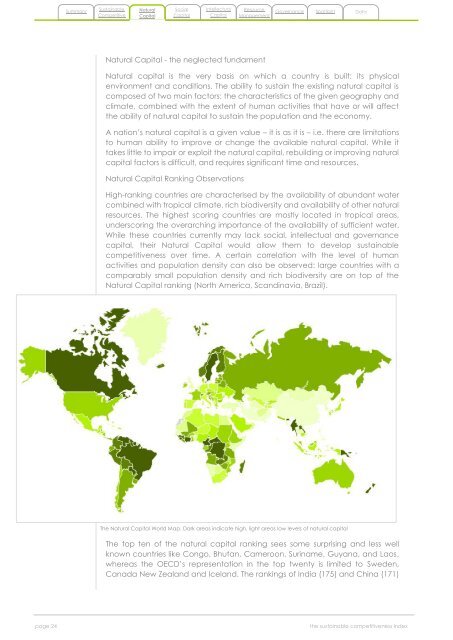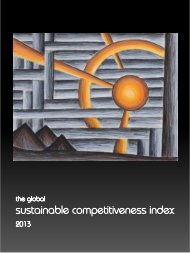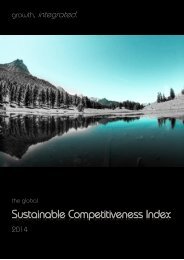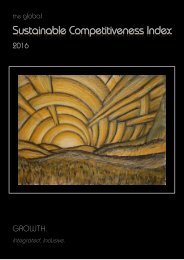The-Global-Sustainable-Competitiveness-Index-2015
You also want an ePaper? Increase the reach of your titles
YUMPU automatically turns print PDFs into web optimized ePapers that Google loves.
Summary<br />
<strong>Sustainable</strong><br />
Competitive<br />
Natural<br />
Capital<br />
Social<br />
Capital<br />
Intellectual<br />
Capital<br />
Resource<br />
Management<br />
Governance Spotlight Data<br />
Natural Capital - the neglected fundament<br />
Natural capital is the very basis on which a country is built: its physical<br />
environment and conditions. <strong>The</strong> ability to sustain the existing natural capital is<br />
composed of two main factors: the characteristics of the given geography and<br />
climate, combined with the extent of human activities that have or will affect<br />
the ability of natural capital to sustain the population and the economy.<br />
A nation’s natural capital is a given value – it is as it is – i.e. there are limitations<br />
to human ability to improve or change the available natural capital. While it<br />
takes little to impair or exploit the natural capital, rebuilding or improving natural<br />
capital factors is difficult, and requires significant time and resources.<br />
Natural Capital Ranking Observations<br />
High-ranking countries are characterised by the availability of abundant water<br />
combined with tropical climate, rich biodiversity and availability of other natural<br />
resources. <strong>The</strong> highest scoring countries are mostly located in tropical areas,<br />
underscoring the overarching importance of the availability of sufficient water.<br />
While these countries currently may lack social, intellectual and governance<br />
capital, their Natural Capital would allow them to develop sustainable<br />
competitiveness over time. A certain correlation with the level of human<br />
activities and population density can also be observed: large countries with a<br />
comparably small population density and rich biodiversity are on top of the<br />
Natural Capital ranking (North America, Scandinavia, Brazil).<br />
<strong>The</strong> Natural Capital World Map. Dark areas indicate high, light areas low levels of natural capital<br />
<strong>The</strong> top ten of the natural capital ranking sees some surprising and less well<br />
known countries like Congo, Bhutan, Cameroon, Suriname, Guyana, and Laos,<br />
whereas the OECD’s representation in the top twenty is limited to Sweden,<br />
Canada New Zealand and Iceland. <strong>The</strong> rankings of India (175) and China (171)<br />
page 24<br />
the sustainable competitiveness index








